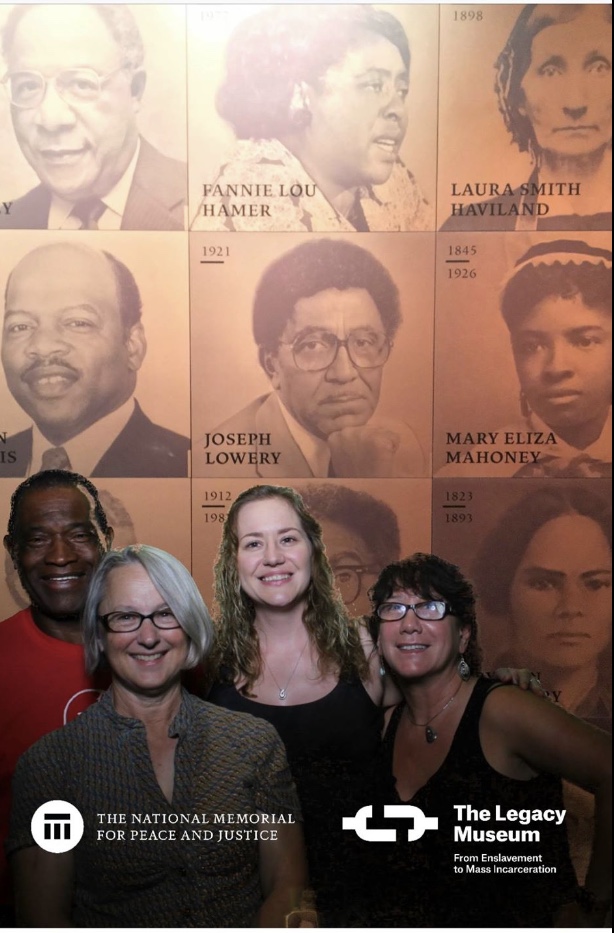
Last spring, the Denton Record-Chronicle’s Peggy Heinkel-Wolfe (’83, ’02 M.J.) called Chelsea Stallings (’09, ’15 M.A.) to discuss the history scholar’s research into Quakertown — a once-thriving African American neighborhood in Denton that was unceremoniously uprooted by city officials in the early 1920s — that was the subject of Stallings’ thesis as a UNT grad student. As the two spoke about the disappearances of African American communities in the area, the conversation turned to the recently opened National Memorial for Peace and Justice in Alabama.
“She said, ‘This museum just opened, and we’re thinking of going there,’” Stallings says.
The “we” in question also included Willie Hudspeth (’90, ’93 M.Ed.), the president of the Denton County NAACP and a longtime local advocate who has worked tirelessly to bring attention and increased care to important African American landmarks in Denton County, such as St. John’s Cemetery in Pilot Point.
In June 2018, the trio — along with Stallings’ friend Michele Beal (’16 M.A.) — embarked on the 12-hour drive to Montgomery, the first step in a sprawling project that seeks to memorialize lynching victims in Denton County. One documented case includes that of two victims who were slain Dec. 14, 1922. The men — whose names are unknown — were taken from the Pilot Point jail, where they were being held in connection with the theft of two horses. A note was found in their place, which threatened “Let this be a warning to all Negro loafers. Negroes get a job or leave town.”
The National Memorial for Peace and Justice seeks to remember victims just like those Denton County men, who are among the more than 4,000 documented cases of African Americans murdered in the U.S. between 1877 and 1950. At the memorial, the names of the victims and the dates of their deaths are inscribed on weathered steel beams shaped like coffins; when it rains, the water that flows over the beams runs red.
“I was pleasantly surprised to see all of the historical information they had — it was really refreshing,” says Hudspeth, who has long fought to spotlight African American history in Denton County despite a scarcity of official documentation. “What they’re planning to do with the nationwide memorial is excellent.”
The group learned about plans for the national memorial after meeting with an attorney from the Equal Justice Initiative — the organization that founded the memorial — who told them about EJI’s Community Remembrance Project, which seeks to recognize the victims of lynching by erecting historical markers, collecting soil from lynching sites, and creating a national memorial that acknowledges the horrors of racial injustice. In the six-acre park surrounding the memorial, he told them, is a field of identical beams that were crafted to be claimed and installed in the U.S. counties they represent. One of those beams includes the victims of the Pilot Point lynching.
“On the way home the next day, we were like, ‘There’s no question we have to do this,’” Stallings says.
In October, Stallings and former UNT communication studies professor Shaun Treat — as part of the newly formed Bring Home Denton’s Beam, which also includes community leaders like Hudspeth — set out to make the three-pronged project a reality. Stallings penned the proposal for the historical marker, which outlined the Pilot Point lynching. It was accepted in January.
Currently, there is no set location for the marker, which Stallings says should be erected by late fall. The Denton Square and St. John’s Cemetery have both been suggested as possibilities.
“All the people who come together to help with this project are going to be the ones making the decisions,” Stallings says. “This is not one person’s project; it’s a coalition. This is an important story, and we want to treat it with dignity and respect.”
Following the installation of the historical marker comes step two of the Community Remembrance Project, which involves soil collection from the sites of local lynchings. Step three is bringing the beam back to Denton County.
“This is a history people don’t want to be reminded of,” Hudspeth says. “But it’s important to not shove this under the rug and let these men — and what happened to them — be remembered. It brings to mind what happened to so many people, and what’s happening to people now. Let’s bring up this history and examine it, so we can teach our children and everyone else to never let this happen again.”
And recognizing the kind of brutality that occurred in Denton County, Stallings notes, is the only way to truly heal and unite as a community.
“Lynching tends to be one of those things where people say, ‘It didn’t happen here, thank God,’” Stallings says. “The reality is, it did happen here. It’s not about shaming people — it’s about acknowledging the men who were lynched. We still don’t know their names, or anything about them, but it’s fair to say they had a family and they didn’t receive a funeral or a chance to say goodbye. I think it’s important to acknowledge that and move forward together.”
Anyone who is interested in helping with Denton County’s Community Remembrance Project can email bringhomedentonsbeam@gmail.com.